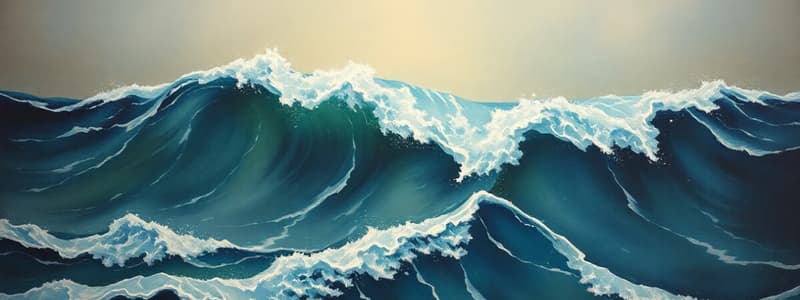Podcast
Questions and Answers
A wave travels from one medium to another, and its speed decreases. Which of the following is most likely to occur as a result of this change in speed?
A wave travels from one medium to another, and its speed decreases. Which of the following is most likely to occur as a result of this change in speed?
- The wave will undergo total internal reflection.
- The wave's wavelength will decrease. (correct)
- The wave's amplitude will increase.
- The wave's frequency will increase.
Two identical sound waves with a frequency of 500 Hz are traveling in the same direction. If these waves are superimposed and create constructive interference, what is the resulting frequency of the combined wave?
Two identical sound waves with a frequency of 500 Hz are traveling in the same direction. If these waves are superimposed and create constructive interference, what is the resulting frequency of the combined wave?
- 250 Hz
- 750 Hz
- 1000 Hz
- 500 Hz (correct)
A guitar string is plucked, producing a standing wave with three antinodes. If the length of the string is 1.5 meters, what is the wavelength of the standing wave?
A guitar string is plucked, producing a standing wave with three antinodes. If the length of the string is 1.5 meters, what is the wavelength of the standing wave?
- 1.0 meter (correct)
- 1.5 meters
- 0.75 meters
- 0.5 meters
A car is moving towards you while honking its horn. Which of the following describes how the sound you hear differs from the sound produced by the horn at rest?
A car is moving towards you while honking its horn. Which of the following describes how the sound you hear differs from the sound produced by the horn at rest?
What phenomenon explains why it is possible to hear someone speaking around the corner of a building, even though you cannot see them?
What phenomenon explains why it is possible to hear someone speaking around the corner of a building, even though you cannot see them?
Which of the following types of electromagnetic radiation has the shortest wavelength?
Which of the following types of electromagnetic radiation has the shortest wavelength?
A light wave passes from air into glass. Which property of the light wave remains unchanged?
A light wave passes from air into glass. Which property of the light wave remains unchanged?
Two speakers are placed side by side emitting sound waves of the same frequency and amplitude. At a certain point in front of the speakers, destructive interference is observed. What can be said about the path length difference from that point to each of the speakers?
Two speakers are placed side by side emitting sound waves of the same frequency and amplitude. At a certain point in front of the speakers, destructive interference is observed. What can be said about the path length difference from that point to each of the speakers?
A transverse wave and a longitudinal wave both have the same frequency and are traveling through the same medium. Which of the following statements is true?
A transverse wave and a longitudinal wave both have the same frequency and are traveling through the same medium. Which of the following statements is true?
The intensity of a sound wave is increased by a factor of 100. By how many decibels does the sound level increase?
The intensity of a sound wave is increased by a factor of 100. By how many decibels does the sound level increase?
Flashcards
What are Waves?
What are Waves?
Disturbances transferring energy through a medium/space, characterized by amplitude, wavelength, frequency and speed.
What are Transverse Waves?
What are Transverse Waves?
Waves where particles move perpendicular to the wave's direction. Light and water waves are examples.
What are Longitudinal Waves?
What are Longitudinal Waves?
Waves where particles move parallel to the wave's direction. Sound waves are an example.
What is Amplitude?
What is Amplitude?
Signup and view all the flashcards
What is Wavelength (λ)?
What is Wavelength (λ)?
Signup and view all the flashcards
What is Frequency (f)?
What is Frequency (f)?
Signup and view all the flashcards
What is Reflection?
What is Reflection?
Signup and view all the flashcards
What is Refraction?
What is Refraction?
Signup and view all the flashcards
What is Diffraction?
What is Diffraction?
Signup and view all the flashcards
What is Interference?
What is Interference?
Signup and view all the flashcards
Study Notes
- Waves are disturbances transferring energy through a medium or space
- Waves are characterized by amplitude, wavelength, frequency, and speed
- Two main types of waves exist: transverse and longitudinal.
Transverse Waves
- Particles of the medium move perpendicularly to the direction of wave propagation
- Examples include light waves, water waves, and waves on a string
Longitudinal Waves
- Particles of the medium move parallel to the direction of wave propagation
- An example is sound waves
Wave Properties
Amplitude
- The maximum displacement of a particle from its equilibrium position
Wavelength
- The distance between two consecutive points in phase, such as crest to crest or trough to trough
- Represented by the symbol λ
Frequency
- The number of complete oscillations or cycles per unit of time
- Measured in Hertz (Hz)
- Denoted by f
Period
- The time taken for one complete oscillation or cycle
- Represented by T
- T = 1/f
Wave Speed
- The speed at which the wave propagates through the medium
- Denoted by v
- v = fλ
Wave Behavior
Reflection
- The bouncing back of a wave when it encounters a boundary
- The angle of incidence is equal to the angle of reflection
Refraction
- The bending of a wave as it passes from one medium to another because of a change in speed
- Governed by Snell's Law: n1sinθ1 = n2sinθ2, where n represents the refractive index
Diffraction
- The spreading of waves as they pass through an opening or around an obstacle
- More pronounced when the wavelength is comparable to the size of the opening or obstacle
Interference
- The superposition of two or more waves resulting in a new wave pattern
- Constructive interference happens when waves are in phase, increasing amplitude
- Destructive interference happens when waves are out of phase, decreasing amplitude
Superposition Principle
- When two or more waves overlap in the same region of space, the resultant displacement at any point is the vector sum of the displacements of the individual waves
Constructive Interference
- Occurs when waves are in phase
- The amplitude of the resultant wave is greater than the amplitudes of the individual waves
Destructive Interference
- Occurs when waves are out of phase
- The amplitude of the resultant wave is smaller than the amplitudes of the individual waves
Standing Waves
- A wave pattern created when two waves of equal frequency and amplitude travel in opposite directions and interfere
- Characterized by nodes (points of zero displacement) and antinodes (points of maximum displacement)
Resonance
- The phenomenon occurring when a system is driven at its natural frequency, resulting in a large amplitude oscillation
- Occurs when the driving frequency matches the natural frequency of the system
Doppler Effect
- The change in frequency or wavelength of a wave in relation to an observer who is moving relative to the wave source
- The frequency increases as the source and observer approach each other
- The frequency decreases as the source and observer move away from each other
Sound Waves
- Longitudinal waves that propagate through a medium (solid, liquid, or gas)
- The range of human hearing is approximately 20 Hz to 20,000 Hz
- The speed of sound depends on the properties of the medium
Intensity
- The power per unit area carried by a sound wave
- Measured in Watts per square meter (W/m^2)
Decibel Scale
- A logarithmic scale utilized to measure sound intensity level
- Measured in decibels (dB)
Electromagnetic Waves
- Transverse waves not requiring a medium to propagate
- Consist of oscillating electric and magnetic fields perpendicular to each other and to the direction of propagation
- Includes radio waves, microwaves, infrared, visible light, ultraviolet, X-rays, and gamma rays
Electromagnetic Spectrum
- The range of all possible frequencies of electromagnetic radiation
- Arranged in order of increasing frequency and decreasing wavelength
Light Waves
- Electromagnetic waves visible to the human eye
- Wavelengths range from approximately 400 nm (violet) to 700 nm (red)
Polarization
- The phenomenon in which the oscillations of a transverse wave are confined to a single plane
- Can occur through reflection, refraction, or absorption
Wave-Particle Duality
- The concept that light and matter exhibit both wave-like and particle-like properties
- Demonstrates that particles can also behave as waves
Studying That Suits You
Use AI to generate personalized quizzes and flashcards to suit your learning preferences.




